As a professional photographer, I’ve had the privilege of capturing some of the most iconic landmarks across the United States. From the towering Statue of Liberty in New York to the breathtaking Golden Gate Bridge in San Francisco, these historic and visually stunning sites offer endless opportunities for creating captivating images. In this comprehensive guide, I’ll share my expert tips and insights to help you plan the perfect American photography adventure and return home with stunning shots that will make your friends and family green with envy.
Whether you’re a seasoned shutterbug or just starting to explore the world of photography, this guide will equip you with the knowledge and techniques needed to capture the essence of these iconic USA landmarks. I’ll delve into the historical significance, optimal viewing angles, and best times to shoot each destination, ensuring you come away with photographs that truly capture the spirit of these remarkable places.
So, pack your camera, lace up your walking shoes, and get ready to embark on an unforgettable photographic journey across the United States. From the most Instagrammable places to hidden gems, this guide will equip you with the knowledge and inspiration needed to create stunning, one-of-a-kind images that will make your social media followers swoon.
The Statue of Liberty: A Symbol of Freedom
The Statue of Liberty, a colossal neoclassical sculpture located on Liberty Island in New York Harbor, is one of the most iconic landmarks in the United States. This magnificent statue, a gift from France to the American people, has stood as a symbol of freedom and democracy for over a century. Towering at 151 feet tall, the Statue of Liberty is a must-see destination for anyone seeking to capture the essence of American ideals in their photographs.
Historical Significance
The Statue of Liberty was dedicated in 1886, designed by French sculptor Frédéric Auguste Bartholdi and engineered by Gustave Eiffel. Its construction was a collaborative effort between the United States and France, representing the enduring friendship between the two nations. The statue’s design, featuring a woman holding a torch and a tablet inscribed with the date of American independence, has become a powerful visual metaphor for the values of liberty and enlightenment.
Best Viewing Spots
- Battery Park in Lower Manhattan offers stunning views of the Statue of Liberty from across the harbor.
- Liberty State Park in New Jersey provides an excellent vantage point, with the Manhattan skyline as a backdrop.
- For a closer look, visitors can take a ferry to Liberty Island and explore the grounds around the statue’s base.
Tips for Capturing the Perfect Shot
- Visit during the golden hour, either early morning or late afternoon, to enjoy the most flattering lighting.
- Experiment with different angles and perspectives to capture the statue’s grandeur and symbolism.
- Use a tripod for long exposures, especially at night, to create dramatic images of the illuminated Statue of Liberty.
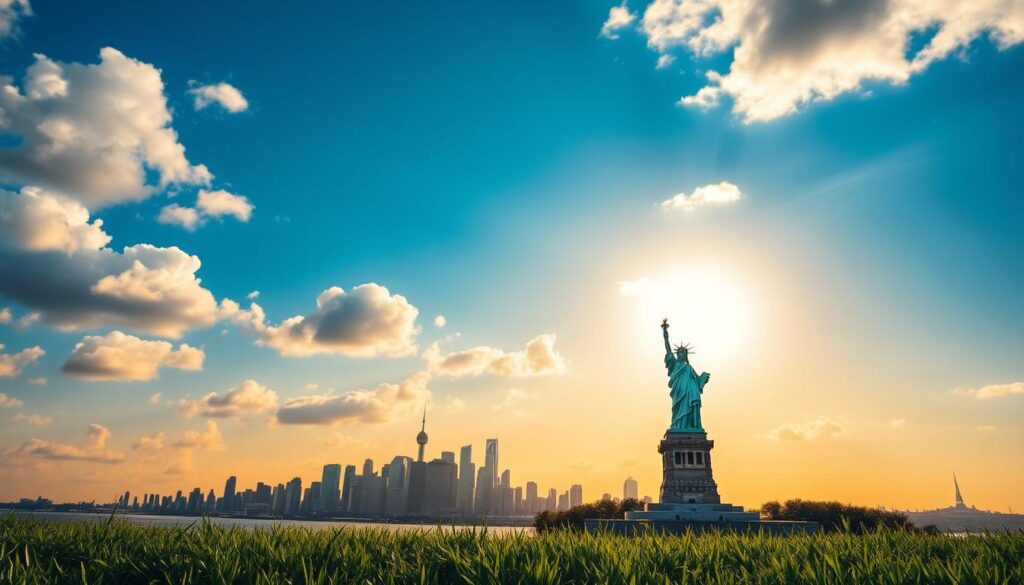
With its rich history and stunning visual appeal, the Statue of Liberty is a must-photograph destination for any visitor to the United States. By understanding the best viewing spots and photography techniques, you can capture the essence of this iconic USA landmark and create stunning images that will forever cherish your iconic USA landmarks for perfect photos.
The Golden Gate Bridge: San Francisco’s Icon
The iconic Golden Gate Bridge is undoubtedly one of the most photographed landmarks in the United States. Known for its striking red hue and the breathtaking views it offers, this architectural marvel is a must-visit destination for photography enthusiasts exploring the iconic USA landmarks for perfect photos.
Unique Photo Angles
Capturing the Golden Gate Bridge from different angles can result in truly captivating images. Some of the best vantage points include:
- Vista Point: Offering a classic, panoramic view of the bridge with the San Francisco skyline in the background.
- Battery Spencer: This former military post provides a unique perspective, allowing you to shoot the bridge from above.
- Crissy Field: Positioned on the shoreline, this location offers the opportunity to frame the bridge within a scenic natural setting.
Best Times for Photography
The Golden Gate Bridge is stunning at any time of day, but certain hours can yield particularly striking results. For the best lighting and minimal crowds, consider visiting during:
- Early morning: Capture the bridge bathed in the warm, golden glow of sunrise.
- Late afternoon: Take advantage of the softer, more dramatic lighting as the sun begins to set.
- Twilight: Photograph the bridge as it is illuminated by its iconic orange lights, creating a breathtaking scene.
Nearby Attractions
Beyond the Golden Gate Bridge itself, San Francisco offers a wealth of iconic USA landmarks for perfect photos in the surrounding area. Consider exploring:
- Alcatraz Island: The former prison on this island offers a unique and historic photo opportunity.
- Exploratorium: This interactive science museum features stunning architecture and exhibits perfect for creative photography.
- Palace of Fine Arts: The grand, domed structure and its picturesque reflecting pool make for a visually stunning backdrop.
With its striking design, captivating vantage points, and abundance of nearby attractions, the Golden Gate Bridge is undoubtedly a must-photograph destination for any visitor to San Francisco.
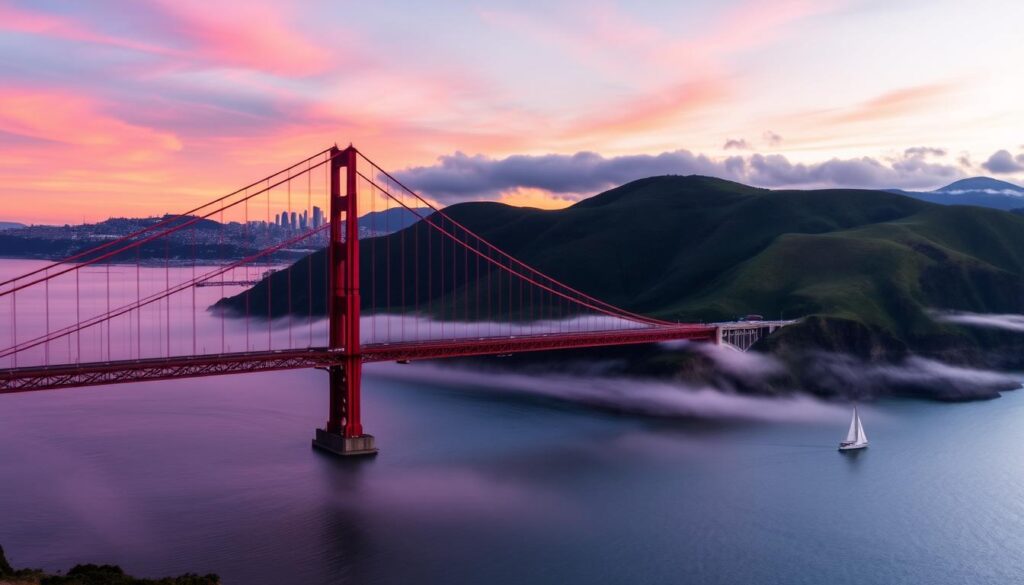
The Grand Canyon: Nature’s Masterpiece
Exploring the majestic Grand Canyon, one of America’s most iconic USA landmarks for perfect photos, is a truly awe-inspiring experience. This natural wonder offers a multitude of breathtaking vantage points to capture its sheer grandeur and stunning landscapes.
Scenic Viewpoints
From the famous South Rim to the lesser-known North Rim, the Grand Canyon boasts an array of scenic overlooks that showcase its immense scale and captivating features. The Hermit’s Rest, designed by the legendary architect Frank Lloyd Wright, provides a unique perspective of the canyon’s layered geology. Similarly, the Mather Point offers a panoramic view of the vast expanse, making it a popular spot for capturing the iconic USA landmarks for perfect photos.
Photographic Techniques
Capturing the grandeur of the Grand Canyon requires a keen eye and specialized photographic techniques. Experimenting with different angles, including low and high vantage points, can help accentuate the canyon’s depth and dramatic shadows. Additionally, mastering the use of neutral density filters can help balance the exposure, allowing you to showcase the vibrant colors and intricate details of this natural wonder.
Essentials for a Day Trip
Planning a successful day trip to the Grand Canyon involves careful preparation. Ensure you pack ample water, sun protection, and sturdy hiking shoes to navigate the various trails and viewpoints comfortably. Additionally, consider packing a portable charger to keep your camera equipment powered throughout the day, allowing you to capture the breathtaking scenes of this iconic USA landmark.
| Scenic Viewpoints | Photographic Techniques | Essentials for a Day Trip |
|---|---|---|
|
|
|
Mount Rushmore: Carved in Stone
Nestled in the heart of South Dakota, Mount Rushmore stands as an iconic American landmark, its colossal granite faces immortalizing the likenesses of four revered U.S. presidents: George Washington, Thomas Jefferson, Theodore Roosevelt, and Abraham Lincoln. This monumental sculpture, overseen by sculptor Gutzon Borglum from 1927 to 1941, serves as a powerful symbol of the nation’s founding, growth, and preservation.
Historical Background
The idea for Mount Rushmore was conceived in the 1920s, when South Dakota historian Doane Robinson proposed the creation of a massive sculpture to attract tourists to the state. Borglum, a renowned sculptor, was selected to lead the project, and he chose the four presidents to represent the nation’s most significant historical figures. The task of carving the 60-foot-tall heads into the granite face of Mount Rushmore was a remarkable engineering feat, undertaken with the help of a team of skilled workers and modern drilling techniques.
Best Times to Visit
The best time to visit Mount Rushmore is during the spring and fall seasons, when the weather is mild and the crowds are smaller. Summer months tend to be the busiest, with long lines and limited parking. For the most breathtaking views, plan your visit around sunrise or sunset, when the changing light casts dramatic shadows across the presidents’ faces.
Photography Tips
- Experiment with different angles and compositions to capture the grandeur of the monument.
- Use a wide-angle lens to fit the entire sculpture into the frame.
- Adjust your exposure settings to account for the bright granite and shadowy areas.
- Bring a tripod for long exposures and low-light conditions.
- Explore the trails and viewpoints around the memorial for unique perspectives.
Whether you’re a seasoned photographer or a casual visitor, Mount Rushmore offers a truly unforgettable experience and the opportunity to capture some of the most iconic USA landmarks for perfect photos.
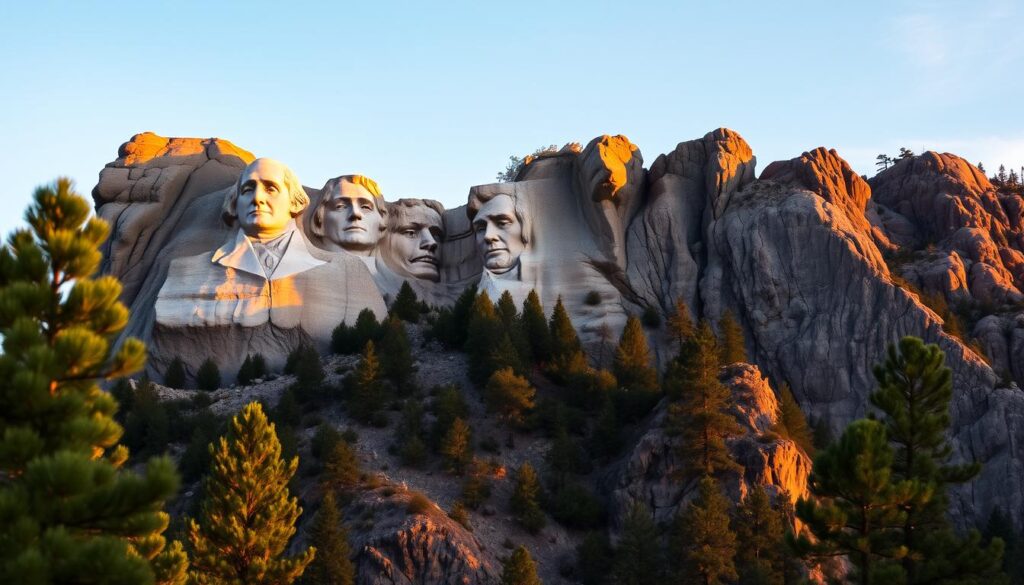
Times Square: The Heart of New York City
Visiting New York City is incomplete without experiencing the electrifying atmosphere of Times Square, a bustling hub of iconic Empire State Building and iconic USA landmarks for perfect photos. As the city that never sleeps, Times Square offers a unique opportunity to capture the vibrant neon lights and energy that make this destination truly unforgettable.
Capturing the Neon Lights
To immortalize the dazzling neon lights of Times Square, try experimenting with long exposures and night photography techniques. Set up your camera on a tripod and adjust the shutter speed to capture the dynamic motion of the city in a single frame. The combination of bright lights, towering billboards, and the constant flow of people creates a captivating visual spectacle that is sure to impress.
Best Times for Photos
While Times Square is a sight to behold at any hour, the most magical moments for photography occur during the golden hour, just before sunset, and in the evening when the neon lights are in full bloom. Arrive early to secure the best vantage points and experiment with different angles to capture the essence of this iconic Empire State Building and iconic USA landmarks for perfect photos location.
Nearby Iconic Locations
After capturing the essence of Times Square, venture out to explore the surrounding area for additional photo opportunities. The Empire State Building, an iconic symbol of the city, offers breathtaking views from its observation decks, providing a unique perspective on the bustling streets below. Additionally, the nearby Broadway theaters and iconic landmarks like the Rockefeller Center and St. Patrick’s Cathedral offer a wealth of photographic possibilities for the discerning traveler.
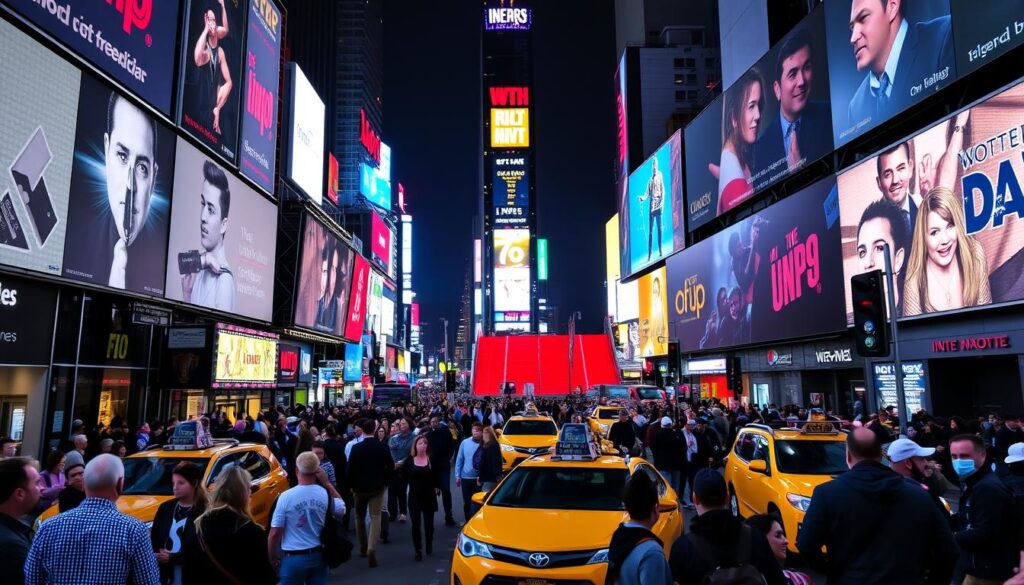
The White House: Political Landmark
As one of the most iconic National Mall landmarks, the White House stands as a symbol of American democracy and political power. Capturing the essence of this historic residence through photography can be a rewarding experience for visitors to the iconic USA landmarks for perfect photos.
Exploring the Grounds
Visitors to the White House can explore the expansive grounds, including the iconic Pennsylvania Avenue and the serene Ellipse. These areas offer unique vantage points to photograph the stately building, with its neoclassical architecture and manicured gardens as the backdrop.
Photography Tips
- Aim for the best lighting conditions, such as the golden hour around sunrise or sunset, to capture the White House in its most flattering light.
- Use a wide-angle lens to capture the full grandeur of the building and its surrounding grounds.
- Experiment with different angles, from the front lawn to the side streets, to find the most compelling composition.
Historical Context
The White House has been the official residence and workplace of the President of the United States since 1800. As a symbol of national pride and political legacy, the White House’s rich history adds depth and meaning to the photographs captured by visitors to the National Mall.
| Landmark | Year Established | Architectural Style | Notable Features |
|---|---|---|---|
| The White House | 1800 | Neoclassical | North Portico, South Lawn, Rose Garden |
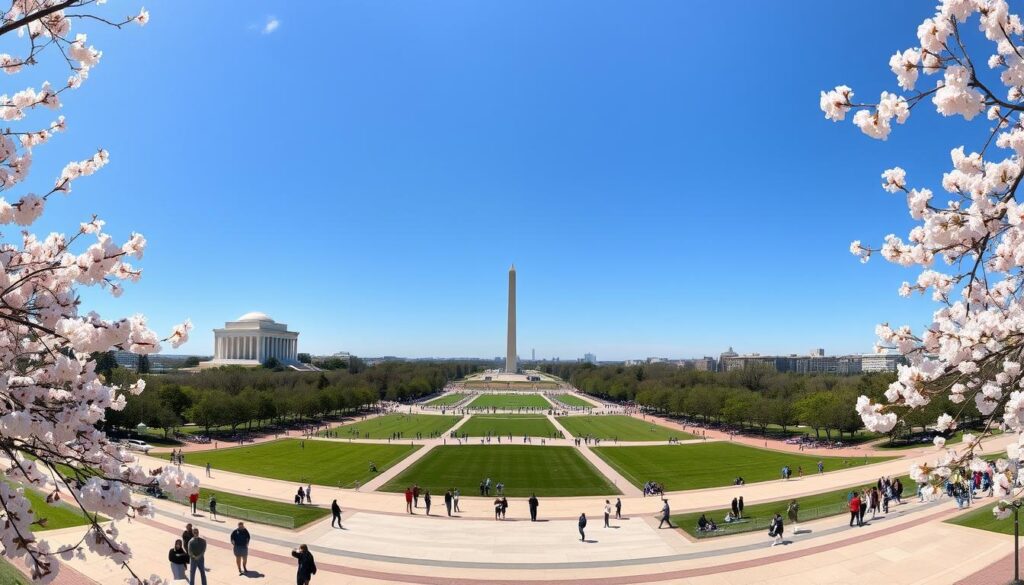
Yellowstone National Park: America’s First National Park
Yellowstone National Park, a true gem of the American West, is a must-visit destination for any traveler seeking to capture the iconic landmarks of the United States. As the first national park in the country, Yellowstone boasts a wealth of natural wonders that have captivated visitors for generations. From the otherworldly geothermal features to the diverse array of wildlife, this park offers a truly unique and unforgettable photographic experience.
Iconic Natural Features
Yellowstone’s landscape is a tapestry of geological marvels, from the awe-inspiring Grand Prismatic Spring to the powerful Old Faithful geyser. These natural wonders provide endless opportunities for striking iconic USA landmarks for perfect photos. Photographers can capture the vibrant hues of the geothermal pools, the dramatic eruptions of the geysers, and the rugged beauty of the park’s canyons and waterfalls.
Wildlife Photography Tips
Yellowstone is also a renowned wildlife haven, home to a diverse array of animals, including bison, elk, bears, and wolves. Capturing the essence of these magnificent creatures requires patience, skill, and a keen eye. Photographers should familiarize themselves with the park’s wildlife regulations, use appropriate lenses, and be mindful of maintaining a safe distance from the animals. With the right techniques, visitors can immortalize the National Mall‘s iconic wildlife in their photographs.
Planning Your Visit
- Research the park’s seasonal highlights and plan your visit accordingly to maximize photographic opportunities.
- Familiarize yourself with the park’s diverse ecosystems and natural features to identify the best locations for your shots.
- Pack the necessary camera gear, including lenses, tripods, and filters, to ensure you’re well-equipped for your photography adventure.
- Consult park maps and guide materials to create an itinerary that allows you to explore the park’s most photogenic areas.
Yellowstone National Park is a treasure trove of iconic USA landmarks for perfect photos, offering a unique and unforgettable experience for both nature enthusiasts and photography enthusiasts alike. By planning your visit and honing your wildlife photography skills, you can capture the essence of this remarkable park and create lasting memories of your first-time travels in the United States.
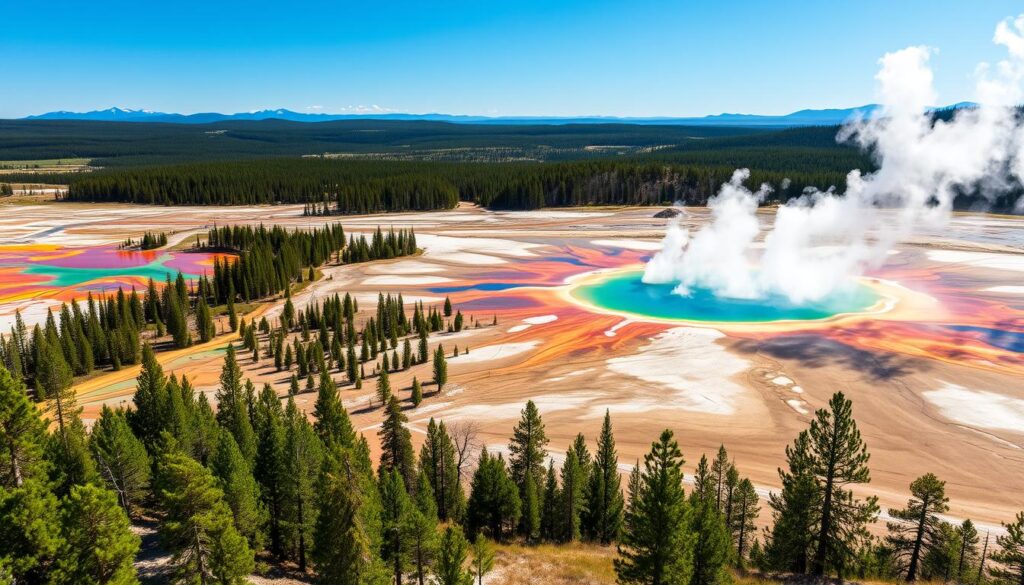
The Space Needle: Seattle’s Skyline Icon
Soaring 605 feet into the sky, the iconic Space Needle is a must-visit landmark for any photographer exploring the iconic USA landmarks for perfect photos. Designed for the 1962 World’s Fair, this futuristic observation tower offers breathtaking panoramic views of Seattle and its stunning natural surroundings.
Optimal Photo Locations
To capture the best shots of the Space Needle, head to Kerry Park, a small urban park located on the slope of Queen Anne Hill. This vantage point provides a classic view of the Space Needle, framed by the Seattle skyline and the majestic Cascade Mountains. For a closer perspective, consider visiting the Observation Deck, where you can snap photos from 520 feet above the ground.
Best Times to Shoot
The Space Needle looks particularly striking at golden hour, the period just before sunrise or sunset when the light takes on a warm, golden hue. During this time, the tower’s sleek, futuristic design and the city’s twinkling lights create a dramatic, picturesque scene. Nighttime photography also offers unique opportunities, as the tower’s powerful beam of light can be seen from miles away on special occasions.
Nearby Attractions
- Chihuly Garden and Glass: Explore the stunning glass sculptures of artist Dale Chihuly, just steps away from the Space Needle.
- Museum of Pop Culture (MoPOP): This iconic museum celebrates the impact of contemporary popular culture, from music to science fiction.
- Seattle Center: The 74-acre campus surrounding the Space Needle features a variety of family-friendly attractions, including the International Fountain and the Seattle Children’s Museum.
| Attraction | Distance from Space Needle | Estimated Time to Reach |
|---|---|---|
| Chihuly Garden and Glass | 0.1 miles | 2 minutes |
| Museum of Pop Culture (MoPOP) | 0.2 miles | 3 minutes |
| Seattle Center | 0.1 miles | 2 minutes |
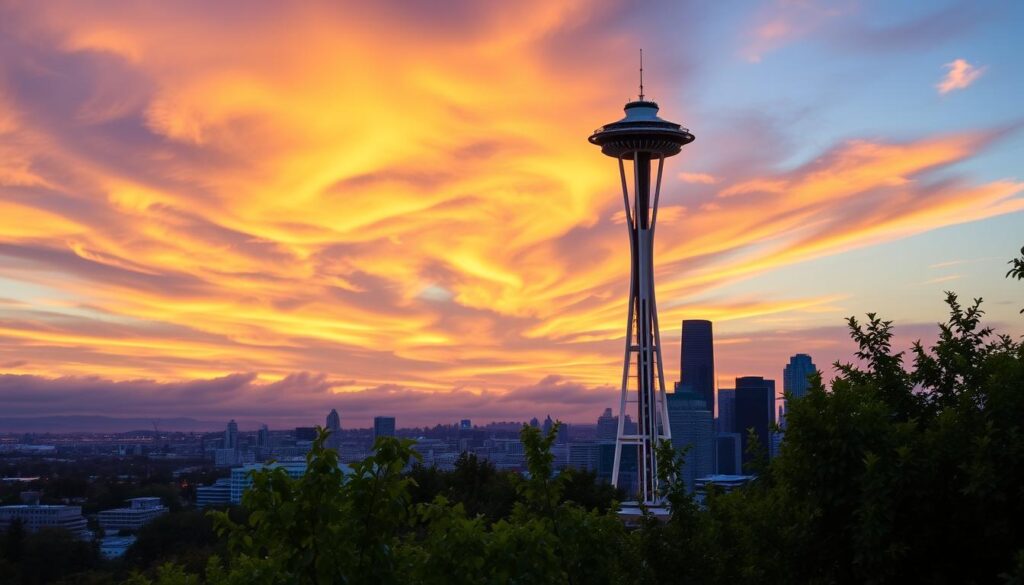
The Alamo: A Historic Texas Landmark
As one of the iconic USA landmarks, the Alamo stands as a powerful symbol of Texas history and resilience. This historic site, located in the heart of San Antonio, offers a unique photographic experience for visitors seeking to capture the essence of American heritage.
Historical Importance
The Alamo holds a significant place in the history of the Texas Revolution. This former mission-turned-fortress was the site of a pivotal battle in 1836, where a small band of Texan defenders made a heroic last stand against the Mexican army. The Alamo’s rich past is etched in the walls and architecture, providing a captivating backdrop for photographers to explore and immortalize.
Best Times for Photography
The Alamo’s photogenic appeal shines brightest during the golden hours of sunrise and sunset. As the warm hues of the day unfold, the mission’s timeless façade is cast in a dramatic light, creating stunning compositions. Visitors should also consider visiting during special events, such as the annual re-enactment of the Battle of the Alamo, to witness the site come alive with living history.
Surrounding Areas to Explore
- The River Walk: Stroll along the picturesque San Antonio River, capturing the city’s vibrant culture and architecture.
- La Villita Historic Arts Village: Discover local artisans and galleries showcasing the rich heritage of Texas in this charming neighborhood.
- Tower of the Americas: Ascend to the observation deck of this iconic landmark for panoramic views of the city and the Alamo.
The Alamo, with its enduring legacy and iconic status, presents a captivating opportunity for photographers seeking to immortalize a piece of America’s past. By exploring the site’s historical significance and surrounding areas, visitors can craft stunning images that capture the essence of this legendary Texas landmark.
The Lincoln Memorial: A Tribute to Leadership
The Lincoln Memorial, a symbol of unity and resilience, is an iconic tribute to President Abraham Lincoln and a significant work of art. Completed in 1922, this monument has played a vital role in various historic events and continues to draw millions of visitors each year for its powerful message and stunning architectural design.
Capturing the Essence
Photographing the Lincoln Memorial is an art form in itself. To capture its grandeur and essence, consider the unique lighting conditions throughout the day. The early morning and late afternoon hours often offer the most dramatic and flattering illumination, casting long shadows and highlighting the memorial’s intricate details.
Tips for Night Photography
The Lincoln Memorial takes on a whole new persona when illuminated at night. The reflective pool and the monument’s floodlit facade create a serene and contemplative atmosphere. Use a tripod to ensure steady shots and experiment with long exposures to accentuate the dramatic lighting. Incorporate the surrounding National Mall landmarks for a more comprehensive and iconic USA photograph.
Commemorative Context
The Lincoln Memorial stands as a testament to the enduring legacy of President Lincoln and the nation’s commitment to unity, equality, and justice. Visitors can explore the memorial’s commemorative context, including the inscription of Lincoln’s second inaugural address and the iconic statue of the 16th president. Understanding the historical significance of this landmark can enhance the photographic experience and deepen one’s appreciation for this iconic USA landmark for perfect photos.
The Hollywood Sign: Icon of the Film Industry
The [https://en.wikipedia.org/wiki/Hollywood_Sign] is an iconic American landmark that has become synonymous with the film industry and the city of Los Angeles. Perched atop Mount Lee in the Santa Monica Mountains, this legendary sign has been a subject of fascination for visitors and photographers alike, offering stunning vantage points for capturing the perfect shot.
Hiking to the Best Viewpoints
For those seeking the ultimate Hollywood Sign photo experience, hiking to the top of the mountain is a must-do activity. Several trails, such as the Hollyridge Trail and the Wisdom Tree Trail, lead adventurous hikers to breathtaking viewpoints where the sign can be framed against the city skyline or the surrounding natural beauty.
- Hollyridge Trail: A moderate hike offering panoramic views of the Hollywood Sign and the Los Angeles Basin.
- Wisdom Tree Trail: A challenging yet rewarding hike that takes you to a unique viewpoint with the Hollywood Sign and the iconic Wisdom Tree in the frame.
Photo Opportunities at Sunrise
For the most spectacular shots, consider timing your visit to coincide with the sunrise. As the first rays of the sun illuminate the iconic letters, the Hollywood Sign takes on an ethereal quality, creating a picturesque scene that will leave a lasting impression on your photographic journey.
Nearby Attractions
Exploring the Hollywood Sign is just the beginning of your adventure. The surrounding area offers a wealth of additional attractions and experiences that can complement your visit, from the iconic Hollywood Walk of Fame to the vibrant Hollywood Boulevard, where you can immerse yourself in the heart of the entertainment industry.
| Nearby Attraction | Description |
|---|---|
| Hollywood Walk of Fame | A renowned sidewalk featuring the handprints, footprints, and signatures of famous actors, musicians, and other entertainers. |
| Griffith Observatory | A renowned astronomical observatory offering stunning views of the Hollywood Sign and the Los Angeles skyline. |
| Runyon Canyon Park | A popular urban park with hiking trails and panoramic views of the Hollywood Hills and the iconic landmark. |
Whether you’re a seasoned photographer or a casual tourist, the [https://en.wikipedia.org/wiki/Hollywood_Sign] is an iconic USA landmark that offers endless opportunities for creating breathtaking photos. By exploring the best hiking trails, capturing the sign at sunrise, and discovering the surrounding attractions, you can truly immerse yourself in the magic of Hollywood and leave with memories that will last a lifetime.
The Gateway Arch: St. Louis’ Iconic Structure
Towering over the banks of the mighty Mississippi River, the iconic Gateway Arch stands as a testament to the pioneering spirit of America. This stunning stainless steel structure, designed by renowned architect Eero Saarinen, has become a symbol of St. Louis and a must-visit destination for iconic USA landmarks for perfect photos.
Historical Significance
The Gateway Arch commemorates the westward expansion of the United States, celebrating the pivotal role St. Louis played as the “Gateway to the West.” This Niagara Falls-inspired landmark was completed in 1965, and since then, it has captivated millions of visitors with its sleek, modern design and breathtaking views.
Photography Locations
Capturing the perfect shot of the Gateway Arch requires strategic positioning. The best vantage points include the nearby Jefferson National Expansion Memorial, which offers unobstructed views of the arch from the riverfront. For a unique perspective, venture up to the observation deck, where you can gaze out over the city and the winding Mississippi below.
Visiting the Museum
- Explore the museum beneath the arch, which delves into the history and significance of this iconic USA landmarks for perfect photos.
- Ride the tram to the top of the arch for a breathtaking 630-foot view of St. Louis.
- Discover interactive exhibits that showcase the engineering feats behind the arch’s construction.
- Enjoy the stunning architecture and landscaping that complement the iconic structure.
Whether you’re a history buff, a photography enthusiast, or simply in awe of architectural marvels, a visit to the Gateway Arch is a must-do on any Niagara Falls itinerary. Prepare to be captivated by this iconic USA landmarks for perfect photos and the rich heritage it represents.
Antelope Canyon: A Natural Wonder
Nestled in the heart of the Arizona desert, Antelope Canyon is a breathtaking natural landmark that has captivated photographers around the world. This iconic slot canyon is renowned for its striking, undulating rock formations and the enchanting interplay of light and shadow that creates awe-inspiring visual effects.
Photography Techniques
Capturing the essence of Antelope Canyon requires a keen eye and specialized photographic techniques. To master the perfect shot, you’ll need to experiment with different angles, shutter speeds, and exposure settings. Utilizing a wide-angle lens can help you showcase the dramatic scale and depth of the canyon, while a polarizing filter can enhance the vibrant colors and textures of the sandstone walls.
Best Times to Visit
The optimal time to visit Antelope Canyon is during the midday hours when the sun is high in the sky, casting its warm, golden light into the narrow crevices. This is when the most iconic “light beams” are visible, creating a mesmerizing visual display. Visiting during the summer months can also provide the best lighting conditions, though you’ll want to be mindful of the increased crowds and heat.
Nearby Attractions
While Antelope Canyon is undoubtedly the main draw, the surrounding area offers a wealth of additional photography opportunities and natural wonders to explore. Consider visiting the iconic Niagara Falls, one of the USA’s most famous landmarks, or exploring the vast and diverse landscapes of the iconic USA landmarks for perfect photos, such as the Grand Canyon and Monument Valley.
| Photography Technique | Recommended Settings |
|---|---|
| Wide-Angle Lens | 16-35mm, f/8-f/11 |
| Polarizing Filter | To enhance colors and reduce glare |
| Exposure Settings | 1/250s – 1/500s, ISO 100-400 |
National Mall: America’s Tribute to History
Nestled in the heart of Washington, D.C., the National Mall is a sprawling green space that serves as a canvas for some of America’s most iconic landmarks. As you stroll through this historic district, you’ll discover a wealth of photogenic spots that capture the essence of our nation’s past and present.
Key Landmarks Along the Mall
The National Mall boasts a impressive array of memorials, museums, and gardens that are perfect for photography enthusiasts. From the towering Washington Monument to the serene Reflecting Pool, each landmark offers a unique perspective on America’s rich history. Along the way, you’ll encounter the solemn Vietnam Veterans Memorial, the majestic Lincoln Memorial, and the thought-provoking Martin Luther King Jr. Memorial.
Best Photography Spots
When it comes to capturing the perfect shot, the National Mall offers a diverse range of photogenic locations. The iconic National Mall itself provides a stunning backdrop, with the US Capitol Building and the Smithsonian museums lining the landscape. For a bird’s eye view, head to the top of the Washington Monument or the steps of the Lincoln Memorial. And don’t forget to explore the serene gardens and fountains scattered throughout the area.
Seasonal Events
- Cherry Blossom Festival (Spring): Experience the breathtaking pink hues of the cherry blossom trees that adorn the National Mall.
- Fourth of July Celebrations (Summer): Witness the awe-inspiring fireworks display over the National Mall, with the Washington Monument as a picturesque centerpiece.
- National Christmas Tree Lighting (Winter): Capture the festive spirit as the National Mall is adorned with twinkling lights and holiday decorations.
Whether you’re a seasoned photographer or a passionate history enthusiast, the National Mall offers a wealth of opportunities to capture the iconic USA landmarks that define our nation’s identity. By exploring the key landmarks, discovering the best photography spots, and timing your visit with seasonal events, you’ll be well on your way to creating a portfolio of captivating images that showcase the beauty and significance of this remarkable destination.
The Everglades: A Unique Ecosystem
The Everglades, a vast and captivating wetland in southern Florida, offer a remarkable opportunity for nature enthusiasts and photographers alike. This diverse ecosystem is home to a rich tapestry of wildlife, from the iconic American alligator to the elusive Florida panther. As I delve into the heart of this natural wonder, I’m eager to share my insights on the best techniques for capturing the Everglades’ stunning visual array.
Wildlife Photography Tips
Navigating the Everglades requires patience and a keen eye. To capture the essence of its wildlife, I’ve found that slow, steady movements and a telephoto lens are essential. The vibrant plumage of the roseate spoonbill and the graceful flight of the great blue heron can be immortalized with careful planning and a steady hand. Respect for the animals’ natural behaviors is paramount, as it allows me to observe and document their intricate interactions without causing disturbance.
Best Viewing Points
The Everglades offer a variety of vantage points for the discerning photographer. From the serene waterways of the Everglades National Park to the elevated boardwalks of the Shark Valley Visitor Center, I’ve discovered breathtaking perspectives that capture the essence of this remarkable landscape. Each location presents its own unique challenges and opportunities, allowing me to experiment with different techniques and compositions to showcase the Everglades’ natural beauty.
Planning Your Visit
Preparing for a photography expedition in the Everglades requires thoughtful consideration. I’ve learned that the early morning and late afternoon hours offer the best lighting conditions, allowing me to capture the vibrant hues and stunning reflections that this ecosystem is renowned for. Additionally, it’s crucial to pack the right gear, including polarized lenses, waterproof camera equipment, and comfortable attire to navigate the often-humid environments. By planning ahead and being mindful of the Everglades’ delicate balance, I’ve been able to immerse myself in this captivating natural wonder while creating lasting and impactful photographic memories.
Updated for 2025: Find the latest hacks to save on flights and travel smarter.
